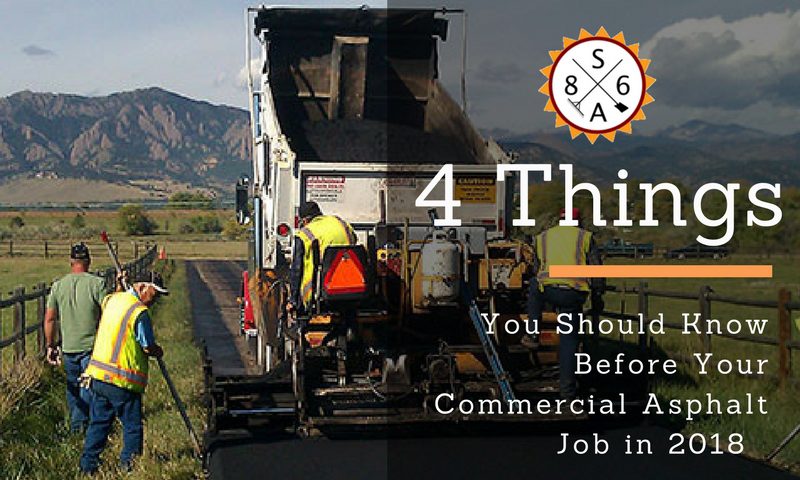

4 Different Types of Paving

Top 5 Tips for Working with Concrete
Concrete has revolutionized operations in the construction industry. It allows both contractors and DIY enthusiasts to easily build walkways, driveways, and other projects without dealing with sophisticated storage procedures. Although working with concrete may seem intimidating to newbies, it is simple and straightforward if you adhere to best practices. Here are the top five tips that will ensure that your concrete project looks great and lasts longer.
1. Include an Additive to Make It Easier to Mix
You don’t have to spend a lot of money buying the most expensive concrete to achieve better results. As a DIY enthusiast, you can begin with the affordable concrete bag from your local hardware. You can stick to the typical mix concrete for simple projects since it doesn’t require additives.
However, if you are working on a large and sophisticated project, add a plasticizer to your concrete since it helps the cement to mix and flow easily. This ensures that the concrete mix gets into all the desired areas. Keep in mind that there is no magic when it comes to drying your concrete. Do not add anything to speed up or slow down the drying time since it may be catastrophic in future. If you’re working in areas that experience hotter temperatures, use a tarp to cover up your mold as it dries.
2. Use Proportionate Amounts of Water
When mixing your concrete, pour a small amount of water into the mixture first and mix for a few minutes until the whole amount of water is absorbed and add more water gradually as you mix. If you add an excessive amount of water at once, the mixture will become runny and hard to deal with. You should also spare a small amount of dry concrete just in case the mix becomes too thin.
You should use either a spade or a flat shovel for mixing. Add water to one side of the mixing tray or wheelbarrow and pull the concrete into it a little amount at a time to ensure that all particles get absorbed. Resist the urge of using a hosepipe to spray water on your mix.
3. Choose the Right Molds for Better Results
Mold materials that produce the best results are usually made out of melamine. Avoid using cardboard as mold since water tends to seep under creating a rough finish. However, in a melamine material, the water can’t escape since it’s non-porous. Instead, your concrete will mimic the melamine’s smooth and attractive look resulting in a perfect finish. No matter the kind of material you choose, just make sure that you make a mold that is strong enough to sustain the heavy concrete.
4. Remember to Wear PPE Before You Start Working with Concrete
Personal protective equipment is essential when working with concrete. It should have both elbow and knee pads, waterproof gloves, dust masks, goggles, and knee-high footwear. Make sure that you put on long pants and long-sleeved shirts when handling wet concrete. Keep in mind that exposure to damp concrete may result in third-degree burns and severe irritation if you aren’t protected adequately.
5. Choose the Right Finish to Make Your Project Look Impressive
Most people tend to think that they have limited options when it comes to the overall appearance of their concrete. However, the truth is that there are lots of simple solutions that can make your concrete project look more attractive, custom, and expensive. Concrete dyes, stamping, and acid stains can all create that impressive look. Polish your concrete with an orbital sander for a smooth finish.
Concrete has revolutionized operations in the construction industry. It allows both contractors and DIY enthusiasts to easily build walkways, driveways, and other projects without dealing with sophisticated storage procedures. Although working with concrete may seem intimidating to newbies, it is simple and straightforward if you adhere to best practices. Here are the top five tips that will ensure that your concrete project looks great and lasts longer.
1. Include an Additive to Make It Easier to Mix
You don’t have to spend a lot of money buying the most expensive concrete to achieve better results. As a DIY enthusiast, you can begin with the affordable concrete bag from your local hardware. You can stick to the typical mix concrete for simple projects since it doesn’t require additives.
However, if you are working on a large and sophisticated project, add a plasticizer to your concrete since it helps the cement to mix and flow easily. This ensures that the concrete mix gets into all the desired areas. Keep in mind that there is no magic when it comes to drying your concrete. Do not add anything to speed up or slow down the drying time since it may be catastrophic in future. If you’re working in areas that experience hotter temperatures, use a tarp to cover up your mold as it dries.
2. Use Proportionate Amounts of Water
When mixing your concrete, pour a small amount of water into the mixture first and mix for a few minutes until the whole amount of water is absorbed and add more water gradually as you mix. If you add an excessive amount of water at once, the mixture will become runny and hard to deal with. You should also spare a small amount of dry concrete just in case the mix becomes too thin.
You should use either a spade or a flat shovel for mixing. Add water to one side of the mixing tray or wheelbarrow and pull the concrete into it a little amount at a time to ensure that all particles get absorbed. Resist the urge of using a hosepipe to spray water on your mix.
3. Choose the Right Molds for Better Results
Mold materials that produce the best results are usually made out of melamine. Avoid using cardboard as mold since water tends to seep under creating a rough finish. However, in a melamine material, the water can’t escape since it’s non-porous. Instead, your concrete will mimic the melamine’s smooth and attractive look resulting in a perfect finish. No matter the kind of material you choose, just make sure that you make a mold that is strong enough to sustain the heavy concrete.
4. Remember to Wear PPE Before You Start Working with Concrete
Personal protective equipment is essential when working with concrete. It should have both elbow and knee pads, waterproof gloves, dust masks, goggles, and knee-high footwear. Make sure that you put on long pants and long-sleeved shirts when handling wet concrete. Keep in mind that exposure to damp concrete may result in third-degree burns and severe irritation if you aren’t protected adequately.
5. Choose the Right Finish to Make Your Project Look Impressive
Most people tend to think that they have limited options when it comes to the overall appearance of their concrete. However, the truth is that there are lots of simple solutions that can make your concrete project look more attractive, custom, and expensive. Concrete dyes, stamping, and acid stains can all create that impressive look. Polish your concrete with an orbital sander for a smooth finish.

What’s the Difference Between Asphalt and Concrete?
Asphalt and concrete are both viable hard surface options for parking lots and driveways, but despite what many may believe, the two are not the same. Yes, there are similarities, such as the importance of a solid base, basic material composition and the need to adequately cure. But to help you make a more educated decision for your refinishing needs, we’ve outlined the top 10 key differences between concrete and asphalt. Have a look:
- Longevity: Concrete can usually last upwards of 40 years, while asphalt has a lifespan of about half of that.
- Durability: To piggyback off the last point in terms of longevity, concrete tends to be more durable than asphalt, which helps it to last longer.
- Aesthetics: Concrete tends to be a lot more versatile of a material than asphalt. For instance, it can be stamped, comes in various colors and has an assortment of finishes available. Asphalt on the other hand is a little less aesthetically pleasing. It comes primarily in black and no finishing options are available.
- Cost: Cost is an important aspect of any project, and a new driveway or parking lot is certainly no exception. On that note, asphalt has a tendency to be cheaper, typically costing anywhere from $2.50 to $4 per square foot. Concrete tends to range from $4 to $6 a square foot.
- Climate considerations: Concrete is generally better in warm climates and asphalt in colder climates. That’s because concrete has a tendency to crack in freezing temperatures and can be damaged by salt. Asphalt, on the other hand, tends to soften in hot temperatures, potentially leading to deformation. Asphalt can get very hot to the touch in warm, sunny climates as well.
- The adhesive: One of the biggest differences between concrete and asphalt is the adhesive that binds the mineral, stone and sand materials together. In concrete, the adhesive is cement. In asphalt, it’s tar.
- Cure time: Concrete takes a few days to cure before it can be driven on, while asphalt takes just a few hours.
- Resurfacing: Asphalt can be resurfaced to give the lot or driveway a new top coat. Resurfacing isn’t possible with concrete.
- Crack repair: In order to repair cracks, stains or deformations, asphalt can be resurfaced. Standalone cracks and holes can also be easily repaired, with the end product blending in fairly well with the rest of the lot or driveway. This isn’t the case with concrete, as crack repairs are generally far more obvious and potentially unsightly.
- Maintenance: It’s recommended that asphalt lots or driveways be resealed once every three to five years to extend operational use. This is easy to do and doesn’t require any special tools or products. Good maintenance can extend the life of asphalt surfaces. Concrete doesn’t have to be sealed to last, as consumers typically choose to seal a concrete driveway to enhance its appearance.
As you can see, concrete and asphalt are far from the same material, and the differences that we’ve listed above are all important considerations to note when you’re deciding on your next resurfacing project.
So what is best for your parking lot or driveway – asphalt or concrete?
Asphalt and concrete are both viable hard surface options for parking lots and driveways, but despite what many may believe, the two are not the same. Yes, there are similarities, such as the importance of a solid base, basic material composition and the need to adequately cure. But to help you make a more educated decision for your refinishing needs, we’ve outlined the top 10 key differences between concrete and asphalt. Have a look:
- Longevity: Concrete can usually last upwards of 40 years, while asphalt has a lifespan of about half of that.
- Durability: To piggyback off the last point in terms of longevity, concrete tends to be more durable than asphalt, which helps it to last longer.
- Aesthetics: Concrete tends to be a lot more versatile of a material than asphalt. For instance, it can be stamped, comes in various colors and has an assortment of finishes available. Asphalt on the other hand is a little less aesthetically pleasing. It comes primarily in black and no finishing options are available.
- Cost: Cost is an important aspect of any project, and a new driveway or parking lot is certainly no exception. On that note, asphalt has a tendency to be cheaper, typically costing anywhere from $2.50 to $4 per square foot. Concrete tends to range from $4 to $6 a square foot.
- Climate considerations: Concrete is generally better in warm climates and asphalt in colder climates. That’s because concrete has a tendency to crack in freezing temperatures and can be damaged by salt. Asphalt, on the other hand, tends to soften in hot temperatures, potentially leading to deformation. Asphalt can get very hot to the touch in warm, sunny climates as well.
- The adhesive: One of the biggest differences between concrete and asphalt is the adhesive that binds the mineral, stone and sand materials together. In concrete, the adhesive is cement. In asphalt, it’s tar.
- Cure time: Concrete takes a few days to cure before it can be driven on, while asphalt takes just a few hours.
- Resurfacing: Asphalt can be resurfaced to give the lot or driveway a new top coat. Resurfacing isn’t possible with concrete.
- Crack repair: In order to repair cracks, stains or deformations, asphalt can be resurfaced. Standalone cracks and holes can also be easily repaired, with the end product blending in fairly well with the rest of the lot or driveway. This isn’t the case with concrete, as crack repairs are generally far more obvious and potentially unsightly.
- Maintenance: It’s recommended that asphalt lots or driveways be resealed once every three to five years to extend operational use. This is easy to do and doesn’t require any special tools or products. Good maintenance can extend the life of asphalt surfaces. Concrete doesn’t have to be sealed to last, as consumers typically choose to seal a concrete driveway to enhance its appearance.
As you can see, concrete and asphalt are far from the same material, and the differences that we’ve listed above are all important considerations to note when you’re deciding on your next resurfacing project.
So what is best for your parking lot or driveway – asphalt or concrete?

How to Measure a Commercial Pavement Job
When it comes owning your own business, there are many factors to take into consideration. From the location of your business to the marketing methods you will take advantage of, all of these factors will come with a cost. One of the most commonly overlooked factors is how much it will cost to pave your commercial property. Fortunately, though, there are tips you can follow to help you develop an accurate commercial pavement cost. Let’s take a quick look at how you can go about developing your own pavement estimate. You can use this estimate when choosing between different commercial pavement companies.
Specific Factors that Will Impact your Take-off and Pricing
First and foremost, the project size, as well as the constructability, will impact the cost of paving your commercial property. For example, if your project requires the use of an unconventional paving method, this will likely drive up the overall total cost. Other factors that will impact the cost include:
- The duration of the project
- The acceleration progress of the project
- The season in which the project is to take place
- The time of day in which workers will be working
- The potential for escalation
Additionally, you will need to take into consideration the types of permits that will be required to pave the commercial property. You may be required to obtain special permits from a number of regulatory agencies.
The five factors that will impact your commercial paving project the most are:
- The size of the parking lot
- The leveling that has to take place
- Cost of materials
- Labor prices
- The types of drainage that must be installed
Developing an Estimate
When it comes to estimating the cost of your commercial pavement project, you will first need to get an accurate estimate of how much area is going to be paved. If the area of your project is in a perfect square, developing an estimate of the area to be covered is going to be quite simple. All you have to do is take the length of the square and multiply it by the width of the square. For example, if width and length of the square are 150 feet by 100 feet, then the total area will be 15,000 square feet.
If, however, the area of your project is not a perfect square, then you will need to turn to the help of any existing blueprints. In fact, if you have an existing blueprint, the area of the project may already be listed. If you are measuring the area of the project by hand, you can use simple measuring tools. It is advised that you break down the area into geometrical shapes. Once you have calculated the area of each shape, simply add all of the totals together to get the total area of ground that is going to be paved.
Please keep in mind that in addition to the width and length of your project, you will also need to account for the depth of the pavement. Generally, the easiest way to come up with an accurate estimate is to use an asphalt calculator, which takes into account the width, length, and depth of the pavement to be laid. There are a variety of asphalt companies in Denver that use these calculators to develop project costs.
When it comes owning your own business, there are many factors to take into consideration. From the location of your business to the marketing methods you will take advantage of, all of these factors will come with a cost. One of the most commonly overlooked factors is how much it will cost to pave your commercial property. Fortunately, though, there are tips you can follow to help you develop an accurate commercial pavement cost. Let’s take a quick look at how you can go about developing your own pavement estimate. You can use this estimate when choosing between different commercial pavement companies.
Specific Factors that Will Impact your Take-off and Pricing
First and foremost, the project size, as well as the constructability, will impact the cost of paving your commercial property. For example, if your project requires the use of an unconventional paving method, this will likely drive up the overall total cost. Other factors that will impact the cost include:
- The duration of the project
- The acceleration progress of the project
- The season in which the project is to take place
- The time of day in which workers will be working
- The potential for escalation
Additionally, you will need to take into consideration the types of permits that will be required to pave the commercial property. You may be required to obtain special permits from a number of regulatory agencies.
The five factors that will impact your commercial paving project the most are:
- The size of the parking lot
- The leveling that has to take place
- Cost of materials
- Labor prices
- The types of drainage that must be installed
Developing an Estimate
When it comes to estimating the cost of your commercial pavement project, you will first need to get an accurate estimate of how much area is going to be paved. If the area of your project is in a perfect square, developing an estimate of the area to be covered is going to be quite simple. All you have to do is take the length of the square and multiply it by the width of the square. For example, if width and length of the square are 150 feet by 100 feet, then the total area will be 15,000 square feet.
If, however, the area of your project is not a perfect square, then you will need to turn to the help of any existing blueprints. In fact, if you have an existing blueprint, the area of the project may already be listed. If you are measuring the area of the project by hand, you can use simple measuring tools. It is advised that you break down the area into geometrical shapes. Once you have calculated the area of each shape, simply add all of the totals together to get the total area of ground that is going to be paved.
Please keep in mind that in addition to the width and length of your project, you will also need to account for the depth of the pavement. Generally, the easiest way to come up with an accurate estimate is to use an asphalt calculator, which takes into account the width, length, and depth of the pavement to be laid. There are a variety of asphalt companies in Denver that use these calculators to develop project costs.

4 Things You Should Know Before Your Commercial Asphalt Job in 2018
The new year brings brand new opportunities for professionals in the commercial asphalt industry. The slow, but steady five percent growth trends of prior years are expected to continue through 2018. As a result, you might be seeing an influx of work opportunities coming your way. When the work comes in, you will want to be ready to outperform your competitors and become the best asphalt company in Colorado. Thankfully, you can attend to the four following areas to make sure you are prepared for your upcoming commercial asphalt jobs.
Partner Strengths and Weaknesses
Your business partner is your greatest asset and also your greatest liability. You must know your partner’s strengths and weaknesses to make sure you can collaborate on all your projects. Assess your partner’s abilities along with your own to ensure your company can meet the challenges that come your way. If you cannot create a balanced team, consider restructuring your commercial asphalt companies before moving on with large-scale commercial asphalt jobs.
Lot Location and Restrictions
Numerous challenges can arise due to the lot size and location, so it is important to clearly understand the project limitations from the beginning. Look at all the possible scenarios and make sure to have several contingency plans on hand in case any of the identified potential challenges actually arise. You should also research the building restrictions in your target work areas to understand how to proceed with your projects. If you start jobs without paying attention to local regulations, you may end up having to redo portions of the project or even halt your work altogether.
Job Size, Start to Finish
You must adequately plan for small and large-scale projects to complete your jobs by the deadline. You can provide quality work for projects of all sizes by finding a way to easily scale your operations. You should have fluid access to a workforce and materials to projects of any size moving forward as expected. Open up your network of asphalt maintenance companies and professionals to have overflow workers available when the job demand extra hands.
Seasonal Weather Patterns
As an asphalt professional, you must pay close attention to seasonal weather patterns to avoid project disruptions. Adverse temperatures and conditions can affect the quality of your finished product, so you must know how to proceed when those situations arise. You can look at weather patterns from prior years to see when it would be best to start your outdoor projects. For this area, you also need to have contingency plans in case weather conditions rapidly change in the middle of your projects.
Starting Your Commercial Asphalt Job in 2018
By addressing the above issues ahead of time, you can achieve great results on all your commercial asphalt jobs in 2018 and beyond. Remember to readdress each category at the start of every project you receive to ensure you are on the right track. In the end, you will never be caught off guard and unprepared to complete the job by the deadline by taking a measured approach to your business activities. If you are ready to acquire support for your company’s endeavors, contact Superior Aggregates today.
The new year brings brand new opportunities for professionals in the commercial asphalt industry. The slow, but steady five percent growth trends of prior years are expected to continue through 2018. As a result, you might be seeing an influx of work opportunities coming your way. When the work comes in, you will want to be ready to outperform your competitors and become the best asphalt company in Colorado. Thankfully, you can attend to the four following areas to make sure you are prepared for your upcoming commercial asphalt jobs.
Partner Strengths and Weaknesses
Your business partner is your greatest asset and also your greatest liability. You must know your partner’s strengths and weaknesses to make sure you can collaborate on all your projects. Assess your partner’s abilities along with your own to ensure your company can meet the challenges that come your way. If you cannot create a balanced team, consider restructuring your commercial asphalt companies before moving on with large-scale commercial asphalt jobs.
Lot Location and Restrictions
Numerous challenges can arise due to the lot size and location, so it is important to clearly understand the project limitations from the beginning. Look at all the possible scenarios and make sure to have several contingency plans on hand in case any of the identified potential challenges actually arise. You should also research the building restrictions in your target work areas to understand how to proceed with your projects. If you start jobs without paying attention to local regulations, you may end up having to redo portions of the project or even halt your work altogether.
Job Size, Start to Finish
You must adequately plan for small and large-scale projects to complete your jobs by the deadline. You can provide quality work for projects of all sizes by finding a way to easily scale your operations. You should have fluid access to a workforce and materials to projects of any size moving forward as expected. Open up your network of asphalt maintenance companies and professionals to have overflow workers available when the job demand extra hands.
Seasonal Weather Patterns
As an asphalt professional, you must pay close attention to seasonal weather patterns to avoid project disruptions. Adverse temperatures and conditions can affect the quality of your finished product, so you must know how to proceed when those situations arise. You can look at weather patterns from prior years to see when it would be best to start your outdoor projects. For this area, you also need to have contingency plans in case weather conditions rapidly change in the middle of your projects.
Starting Your Commercial Asphalt Job in 2018
By addressing the above issues ahead of time, you can achieve great results on all your commercial asphalt jobs in 2018 and beyond. Remember to readdress each category at the start of every project you receive to ensure you are on the right track. In the end, you will never be caught off guard and unprepared to complete the job by the deadline by taking a measured approach to your business activities. If you are ready to acquire support for your company’s endeavors, contact Superior Aggregates today.
